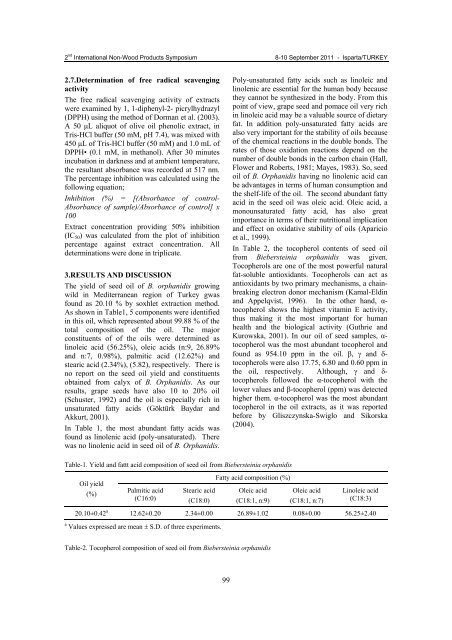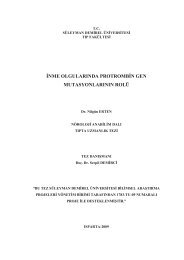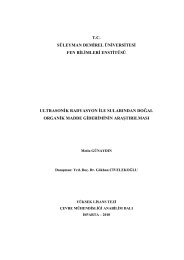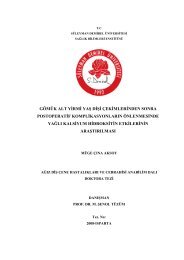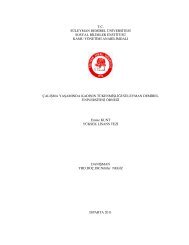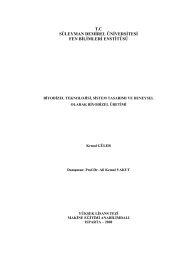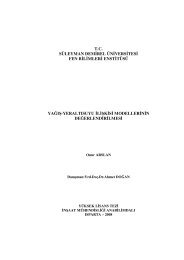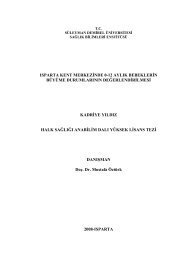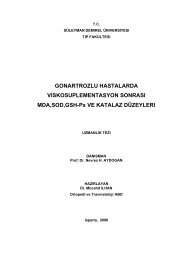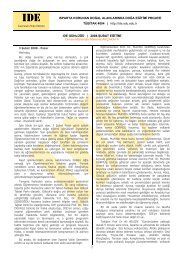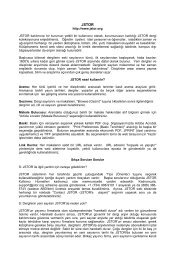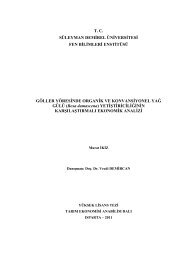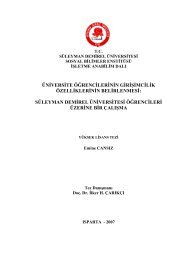Proceedings Book / Bildiri Kitabı - Orman Fakültesi - Süleyman ...
Proceedings Book / Bildiri Kitabı - Orman Fakültesi - Süleyman ...
Proceedings Book / Bildiri Kitabı - Orman Fakültesi - Süleyman ...
You also want an ePaper? Increase the reach of your titles
YUMPU automatically turns print PDFs into web optimized ePapers that Google loves.
2 nd International Non-Wood Products Symposium 8-10 September 2011 - Isparta/TURKEY<br />
2.7.Determination of free radical scavenging<br />
activity<br />
The free radical scavenging activity of extracts<br />
were examined by 1, 1-diphenyl-2- picrylhydrazyl<br />
(DPPH) using the method of Dorman et al. (2003).<br />
A 50 μL aliquot of olive oil phenolic extract, in<br />
Tris-HCl buffer (50 mM, pH 7.4), was mixed with<br />
450 μL of Tris-HCl buffer (50 mM) and 1.0 mL of<br />
DPPH• (0.1 mM, in methanol). After 30 minutes<br />
incubation in darkness and at ambient temperature,<br />
the resultant absorbance was recorded at 517 nm.<br />
The percentage inhibition was calculated using the<br />
following equation;<br />
Inhibition (%) = [(Absorbance of control-<br />
Absorbance of sample)/Absorbance of control] x<br />
100<br />
Extract concentration providing 50% inhibition<br />
(IC 50 ) was calculated from the plot of inhibition<br />
percentage against extract concentration. All<br />
determinations were done in triplicate.<br />
3.RESULTS AND DISCUSSION<br />
The yield of seed oil of B. orphanidis growing<br />
wild in Mediterranean region of Turkey gwas<br />
found as 20.10 % by soxhlet extraction method.<br />
As shown in Table1, 5 components were identified<br />
in this oil, which represented about 99.88 % of the<br />
total composition of the oil. The major<br />
constituents of of the oils were determined as<br />
linoleic acid (56.25%), oleic acids (n:9, 26.89%<br />
and n:7, 0.98%), palmitic acid (12.62%) and<br />
stearic acid (2.34%), (5.82), respectively. There is<br />
no report on the seed oil yield and constituents<br />
obtained from calyx of B. Orphanidis. As our<br />
results, grape seeds have also 10 to 20% oil<br />
(Schuster, 1992) and the oil is especially rich in<br />
unsaturated fatty acids (Göktürk Baydar and<br />
Akkurt, 2001).<br />
In Table 1, the most abundant fatty acids was<br />
found as linolenic acid (poly-unsaturated). There<br />
was no linolenic acid in seed oil of B. Orphanidis.<br />
Poly-unsaturated fatty acids such as linoleic and<br />
linolenic are essential for the human body because<br />
they cannot be synthesized in the body. From this<br />
point of view, grape seed and pomace oil very rich<br />
in linoleic acid may be a valuable source of dietary<br />
fat. In addition poly-unsaturated fatty acids are<br />
also very important for the stability of oils because<br />
of the chemical reactions in the double bonds. The<br />
rates of those oxidation reactions depend on the<br />
number of double bonds in the carbon chain (Hall,<br />
Flower and Roberts, 1981; Mayes, 1983). So, seed<br />
oil of B. Orphanidis having no linolenic acid can<br />
be advantages in terms of human consumption and<br />
the shelf-life of the oil. The second abundant fatty<br />
acid in the seed oil was oleic acid. Oleic acid, a<br />
monounsaturated fatty acid, has also great<br />
importance in terms of their nutritional implication<br />
and effect on oxidative stability of oils (Aparicio<br />
et al., 1999).<br />
In Table 2, the tocopherol contents of seed oil<br />
from Biebersteinia orphanidis was given.<br />
Tocopherols are one of the most powerful natural<br />
fat-soluble antioxidants. Tocopherols can act as<br />
antioxidants by two primary mechanisms, a chainbreaking<br />
electron donor mechanism (Kamal-Eldin<br />
and Appelqvist, 1996). In the other hand, α-<br />
tocopherol shows the highest vitamin E activity,<br />
thus making it the most important for human<br />
health and the biological activity (Guthrie and<br />
Kurowska, 2001). In our oil of seed samples, α-<br />
tocopherol was the most abundant tocopherol and<br />
found as 954.10 ppm in the oil. β, and -<br />
tocopherols were also 17.75, 6.80 and 0.60 ppm in<br />
the oil, respectively. Although, γ and δ-<br />
tocopherols followed the α-tocopherol with the<br />
lower values and -tocopherol (ppm) was detected<br />
higher them. α-tocopherol was the most abundant<br />
tocopherol in the oil extracts, as it was reported<br />
before by Gliszczynska-Swiglo and Sikorska<br />
(2004).<br />
Table-1. Yield and fattt acid composition of seed oil from Biebersteinia orphanidis<br />
Oil yield<br />
(%)<br />
Palmitic acid<br />
(C16:0)<br />
Fatty acid composition (%)<br />
Stearic acid Oleic acid Oleic acid<br />
(C18:0) (C18:1, n:9) (C18:1, n:7)<br />
Linoleic acid<br />
(C18:3)<br />
20.10±0.42 a 12.62±0.20 2.34±0.00 26.89±1.02 0.08±0.00 56.25±2.40<br />
a Values expressed are mean S.D. of three experiments.<br />
Table-2. Tocopherol composition of seed oil from Biebersteinia orphanidis<br />
99


